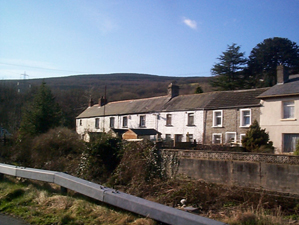Historic Landscape
Characterisation
Merthyr Tydfil
016 Upper Abercanaid
HLCA 016 Upper Abercanaid Important early canal side colliery
settlement and Glyndyrys pit (engine house).
Click here for a
character area map
Summary
An important early 19th century canal-side colliery associated with Glyndyrys Pit and Plymouth Colliery. It contains good examples of early 19th century industrial vernacular housing.
Historical background
The historic landscape area of Upper Abercanaid comprises an early 19th century industrial settlement constructed between the parish road and the Glamorganshire Canal.
Between 1814 and 1832, early OS maps show the settlement comprised two parallel rows of cottages, with a mine to the west. The original settlement of Abercanaid, which comprised a range of farm buildings and farmhouse set within sub-rectangular enclosure, lay within the adjacent just west of the Parish Road and the Glamorganshire Canal; this has now been demolished.
The first detailed depiction of the settlement is that of the 1850 Tithe, which showed two parallel rows as before, plus additional rows along the lane to Gwaun Wyllt (Waunwyllt) Farm. The settlement contained a large villa, Upper Abercanaid House at its core (Garden walls and piers listed grade II). The area was part of Thomas Thomas's estate at this date. A Welsh Baptist chapel, Shiloh Chapel, was shown by 1878, while north of Abercanaid were two engine houses, an adjacent airshaft, and ironstone level, all of which appear to have been redundant by 1919. In the period up to 1919, the westernmost of the two parallel rows appeared to have been demolished. The adjacent mining features noted included the Glyndyrys Pit, together with two other associated pits within the settlement itself, and a level just to the west of the Baptist Chapel (GRO/D/D HSE/1).
